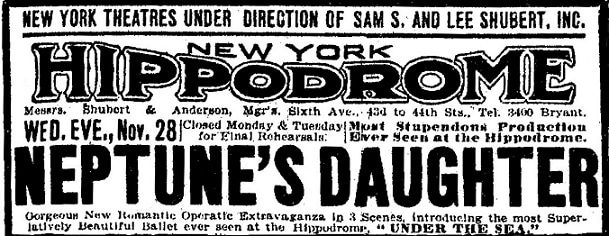|
Almost immediately after the show's debut, the New York Times observed, "No spectacular invention or innovation of recent years has aroused such popular curiosity as the mermaid scene in Neptune's Daughter at the Hippodrome. The mermaids, who are only mortal actresses and by no means amphibious, first rise to view in the very midst of the tank, which is supposed to represent the briny deep." Mystery and curiosity, the producers believed, would draw crowds: The rehearsals, when there was any danger that the scheme might be revealed, were conducted with the utmost secrecy. Every attache of the Hippodrome who had an opportunity to discover the truth was solemnly pledged to tell nothing. The mermaids 'hoped they might die' if they told, and knew they would lose their positions in case they had the hardihood to break faith with the management. The projectors of the enterprise believed that the greatest advertisement that they could have would be the greatest mystery they could muster. For business purposes, they protected themselves with patents. For box office purposes, they determined to mystify the City of New York. Where there is a mystery to solve, someone will solve it. Where there is a story to leak, someone will leak it. How the mermaids in the Hippodrome production of Neptune's Daughter enter and go out apparently through the bottom of the tank, how they contrive to go under water at will and stay down until it is time for them to come to the surface again, has been discovered. It is not really so wonderful. In fact, this apparent marvel of modern science is merely an adaptation of the diving bell principle, which was worked out a great many years ago. Comments are closed.
|
AuthorI am a retired community college professor and the great-granddaughter of composer, orchestrator, arranger, organist, and teacher William Christopher O'Hare. Click the "Read More" link to see each full blog entry.
Archives
November 2020
Categories
All
|


 RSS Feed
RSS Feed